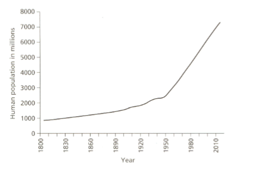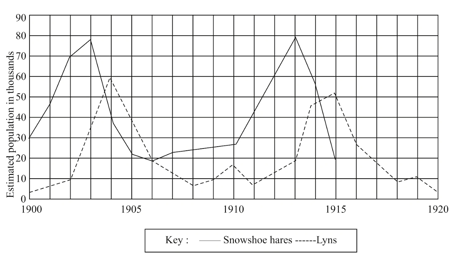Aiden Gill, Heidi Foxford and, Dorothy Warren Solutions for Chapter: Ecology, Exercise 3: Exercise 3
Aiden Gill Science Solutions for Exercise - Aiden Gill, Heidi Foxford and, Dorothy Warren Solutions for Chapter: Ecology, Exercise 3: Exercise 3
Attempt the practice questions on Chapter 3: Ecology, Exercise 3: Exercise 3 with hints and solutions to strengthen your understanding. Cambridge Lower Secondary Science Stage 9: Workbook solutions are prepared by Experienced Embibe Experts.
Questions from Aiden Gill, Heidi Foxford and, Dorothy Warren Solutions for Chapter: Ecology, Exercise 3: Exercise 3 with Hints & Solutions
Name one physical factor that could limit a plant population at the bottom of the lake.
The graph shows how the human population has changed since 1800.

Which two of the following are possible reasons for the changes in the human population size. choose the correct answer.
The graph shows how the estimated population of snowshoe hares and lynx in one part of Canada changed over 20 years.

| Year | 1916 | 1917 | 1918 | 1919 | 1920 |
| Estimated number of snowshoe hares (in thousand) | 28 | 16 | 9 | 12 | 5 |
a) Use the data shown in the table to finish plotting the line for the snowshoe hares.
b) Describe how the population of Lynx changed between 1913 and 1917.
c) When the snowshoe hare population increased, the Lynx population also started to increase. Explain why.
What is mean by the term extinction?
List two causes of extinction of a population.
Some scientists monitored the population of Cabomba plants in a lake over a period of 6 months.
| Month | January | February | March | April | May | June |
| Number of plants | 765 | 768 | 772 | 483 | 212 | 167 |
Between which months did the number of Cabomba begin to decrease?
Some scientists monitored the population of Cabomba plants in a lake over a period of 6 months.
| Month | January | February | March | April | May | June |
| Number of plants | 765 | 768 | 772 | 483 | 212 | 167 |
List two possible reasons for the decrease in the population of Cabomba plants.
The number of Cabomba plants in the lake was estimated by counting the number in one 'sample' area. Suggest one reason why the data may not be accurate.
